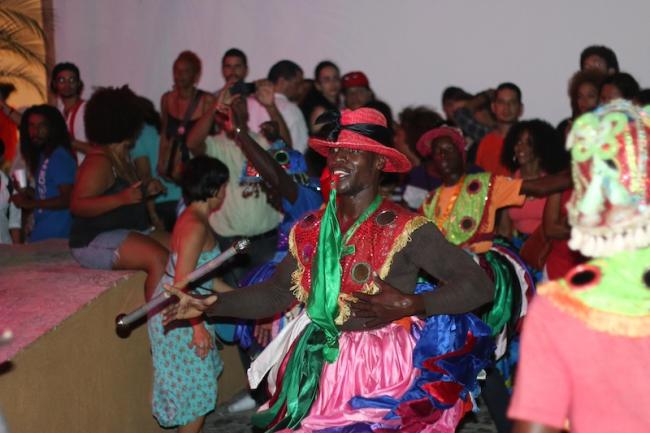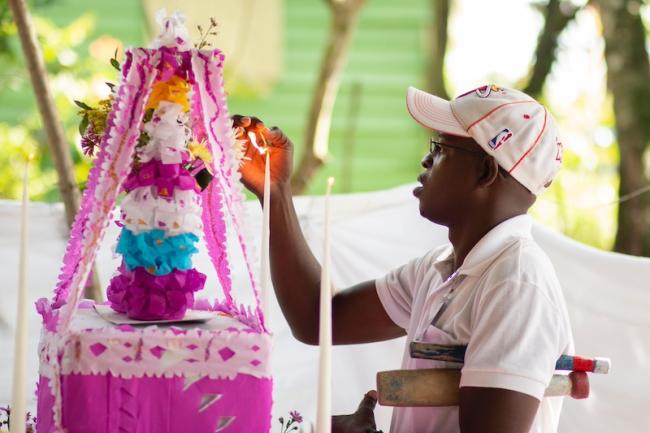
“Are these children taught about God? Are they taught the Bible, do they believe God?” On May 21, 2024, Iván Ruiz, host of the Midday Show, one of the most-watched TV programs in the Dominican Republic, asked these questions to the children’s dance group of the Fundación Cultural Herencia Viva de Mata de los Indios, who had intended to perform Afro-Dominican dances on the show. “I was in shock,” recalled Lisaury del Rosario, the group’s director and choreographer. Ruiz, who heads the State Corporation of Radio and Television, had warned off-camera that “he did not go with that culture… He said: ‘get them in quickly and get them out,’” del Rosario recalled in a public denunciation of the experience. Presumably as a result of Ruiz’s orders, the group did not perform any dance and barely lasted 80 seconds in front of the cameras.
The group had expected to dance on TV as part of an effort to raise funds to attend the Fiesta del Fuego Festival in Santiago de Cuba, to which they had been invited. The producers had asked them if they planned to perform Gagá, a dance linked to a religious celebration of African origin present in both Haiti and the Dominican Republic. Del Rosario had clarified that they wouldn’t. Ruiz asked on the air if they knew how to dance merengue—a popular genre elevated to national primacy during the dictatorship of Rafael Leónidas Trujillo. In a thinly veiled way, the questions about God and merengue are ways of verifying whether the girls, who are Black, are really Dominican.
Mata de los Indios is a community with a strong cultural tradition in North Santo Domingo and the birthplace of legendary figures of Afro-Dominican music, such as Enerolisa Núñez, singer of the salve tradition, and the late folklorist and musician Sixto Minier, known as Father of the Congos for his leading role in the Congos de Villa Mella. The organization is also recognized by UNESCO on its list of Intangible Cultural Heritage of Humanity. Herencia Viva, directed by del Rosario, operates without a physical location or state funding. Still, she is convinced that her work helps to prevent criminal violence in the community and “to fight so that culture is not lost.”
The producers’ questions about Gagá may have been motivated by legal concerns. Regulation 824, governing the National Commission of Public Entertainment and Radio (CNEPR), an agency regulating media broadcasting, censures African dances in the Dominican Republic. Drafted in 1971 by the dictatorship of Joaquín Balaguer, one of its articles bans “rumbas, African dances, strip-tease and all dances which are considered offensive to morality and public decency” from television or live performances in which minors are part of the audience. The regulation instructs the CNEPR to prevent public broadcasts or live performances that “may be detrimental to the principles and norms of the Dominican people.” As such, Afro-Dominican dances are legally restricted because they are deemed anti-national and immoral.
There have been attempts to modernize the CNPER. In 2005, President Leonel Fernández issued a decree to replace Regulation 824. But its censorious content persisted, prohibiting anarchist content and offenses to the official cult of national heroes. In the face of strong opposition, it was repealed within two weeks, and Regulation 824 was reinstated. Another reform was announced in 2021, but nothing was done. A draft “Law of Freedom of Expression,” presented by President Luis Abinader in April 2024, would repeal Regulation 824 and dissolve the CNEPR, replacing it with a new regulatory body with additional tasks, such as monitoring online activity. However, this new law, the text of which remains unknown to the public, has not been approved by Congress. Regulation 824 prohibiting African dances in television is still in force.
Censorship at the Service of Political Control
Clara Morel, president of the Theatre Workers Union (SITEARD), notes Regulation 824 was created to censure activities with a tradition of protest, such as radio broadcasting and theater. “The regulation scheme, in the end, had to do with political control,” she explains. The Law 1951 that created the CNPER prohibits the projection of films featuring “communist artists” or perceived to promote communism. Morel recalls other traditions of African origin, such as the dancing theater group Los Guloyas, which suffered persecution in the first half of the twentieth century based on the notion that traditions of African origin are alien to Dominican culture. “They had to request authorization from a police precinct to carry out their celebrations,” she notes.
Vodou religion is also criminalized by Trujillo’s Law 391. The non-profit organization Identidad Dominicana recently filed an appeal of unconstitutionality against the law. The appeal has been pending since April 2024, but ultra-conservative sectors linked to the government vocally endorse Law 391. In September, Evangelical leader Ezequiel Molina stated in a tweet that Vodou should remain illegal because it is a “satanic cult.” “We are a Christian country. [To legalize it] would be the worst curse,” he declared.

Another legacy of the Trujillo dictatorship is the Concordat with the Catholic Church, recognizing Catholicism as the Dominican state’s official religion. The government subsidizes Protestant and Catholic churches, which even have offices in the National Palace. By law, the Bible must be taught in schools, and every September 27, the government celebrates “Bible Day.” Christian churches play a crucial role in the persistence of discriminatory tropes against Afro-Dominican heritage, as well as the legislation that crystallizes them. For example, the 2023 municipal communiqué announcing a ban on Gagá in Santa Cruz de El Seibo was signed not only by the governor and the mayor but also by representatives of Evangelical churches.
Neotrujillismo and Cultural Repression
The conflict between the ideological and institutional apparatus of the Dominican regime and cultural expressions of African origin is part of a broader system of racist repression. This has been described as an apartheid regime by various authors after the denationalization of hundreds of thousands of Dominicans of Haitian descent in 2013. Even intellectuals affiliated with the current government, such as the ambassador of the Dominican Republic in Mexico, Juan Bolívar Díaz, have denounced Dominican apartheid in the past.
Extensive academic literature recognizes Gagá, Vodou, and other cultural expressions of African origin as part of the Dominican cultural heritage, dating back to the first Spanish colony that brought an enslaved population of African origin in the 15th century. Sociologist Carlos Andújar observed that in the 1990s, more than 40 percent of homes in popular neighborhoods and rural sectors of the Dominican Republic had some altar or symbolic element related to Vodou. June Rosenberg, Dagoberto Tejeda, and Geo Ripley, among many other scholars, have written about the Dominican variant of this religion. Lusitania Martinez locates the beginning of the repression against Vodou and the music and dance of African origin to 1862 in the context of the short-lived re-annexation of the Dominican Republic by Spain. In 1992, the cult of the Cemetery Baron, the most popular manifestation of Dominican Vodou at the time, was banned. That same year, the Columbus Lighthouse, a large cross-shaped concrete building in Santo Domingo, was inaugurated by Balaguer to celebrate the 500th anniversary of the Spanish conquest, exemplifying that "Spanishization" is an unfinished process.
During the current campaign of mass deportations, cultural persecution has intensified. In April 2022, local authorities of the ruling Modern Revolutionary Party (PRM), banned the celebration of the Gagá in the urban area of San Pedro de Macorís, confining it to the bateyes, marginalized communities linked to the sugar industry. San Pedro de Macorís, on the southeastern coast, has a long history of Haitian and English-speaking Caribbean immigration, where Gagá and Guloyas are strong traditions. At the time, the Ministry of Culture criticized the banning of Gagá. However, as Dominican artist Alicia Méndez points out, the ministry has said nothing about attempts by local authorities to ban the Gagá in Santa Cruz del Seibo and Boca Chica in the last two years, as well as other Afro-Dominican traditions such as the Cachúas de Cabral and Máscaras de Bánica.
María Cándido, a member of the Gagá de Los Jovillos community group in Yamasá, about 30 miles north of the capital, says that in 2022 her group was denied a municipal permit to perform processions in other communities. In 2023, the authorities again denied them the permit, claiming that “Gagá is not Dominican culture and the president does not like Gagá.” Similar prohibitions were registered in the communities of El Seibo, San Pedro, and San Luis. In March 2024, Gagá de Los Jovillos finally received a permit. “They were in an electoral campaign,” explains Cándido of the friendlier treatment received by municipal authorities last year.
Two months later, Abinader was reelected. During the campaign, he compared himself to Balaguer and insisted that there is “no Dominican solution to the Haitian problem.” Abinader’s regime defines Haitian immigration as an economic burden and a threat to sovereignty and national security. Massive deportations—around 500,000 between 2023 and 2024—have escalated after Abinader announced a goal of 10,000 deportations per week last October.
“African Influence is Everywhere”
In his 1983 book La Isla al revés, Balaguer affirmed that “African influence in our cultural manifestations has been almost imperceptible.” But the reality is quite different. Afro-Dominican heritage is evident in all popular Dominican musical genres, including merengue, bachata, and dembow, and in gastronomy and language—African influence is everywhere. Additionally, Gagá is a powerful tradition that has influenced many urban, jazz, and fusion musicians in the country. Many of these musicians gathered on April 1, 2023, to support the Gagá group from the batey La Ceja in a concert called Festigagá in Santo Domingo’s zona colonial. Notably, the concert took place despite death threats from the neo-Nazi organization Antigua Orden Dominicana, whose links to the National Police are well documented.
In the face of racist hegemony and official doctrine, a subterranean resistance in a country with an Afro-descendant majority has always existed. “Gagá is restricted on television, and at the level of the elites, but in the end all of us who are from below, Dominicans or Haitians, all get involved with the music. Nobody says that because it is African music they will not dance to it,” says María Cándido.
Even if not on television, the drums will continue to sing.
Simón Rodríguez is an independent journalist and researcher based in the Dominican Republic.

